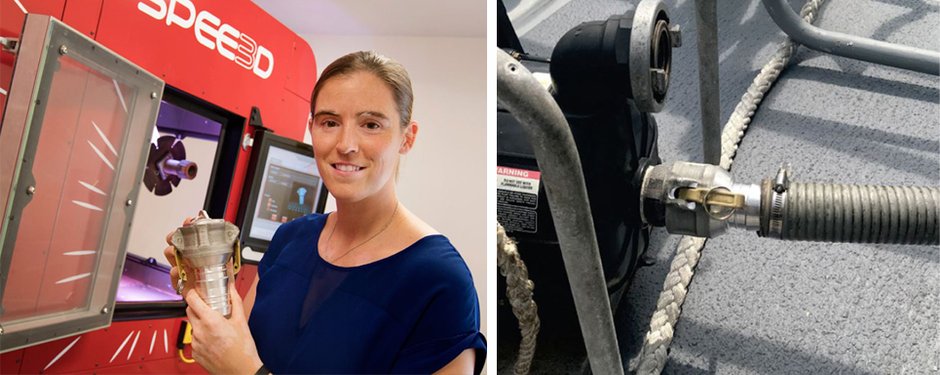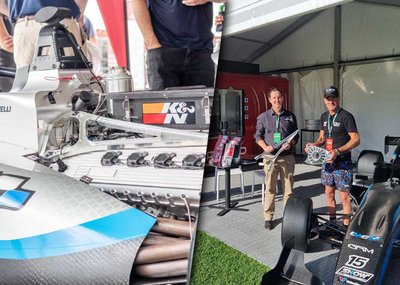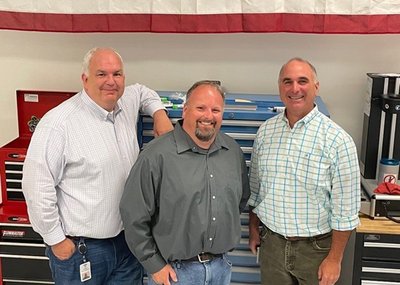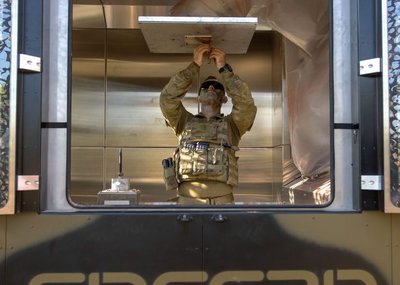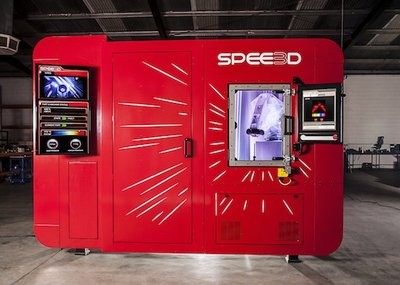PRINT TIME: 24.4 MINUTES
MATERIAL: ALUMINUM 6061
WEIGHT: 660 GRAMS
PART COST: $66
CHALLENGE
To demonstrate the capability of SPEE3D technology to produce metal parts on demand for the Royal Australian Navy.
These parts also need to meet military specifications however the process of 3D printing parts is fundamentally different than conventional manufacturing. Conventional methods already have established pathways for achieving these certifications. The challange was to establish a pathway for 3D printed parts to also achieve the certification. This was a collaborative project with Charles Darwin University (CDU).
SOLUTION
The solution was to print an aluminium camlock hose fitting that was designed as per the relevant military specifications and have this part validated through functional testing.
RESULT
The resulting part was validated and field tested on board an Armidale class patrol boat. The positive results proved the viability of producing certifiable parts with SPEE3D technology.
KEY BENEFITS
- Reduced downtime for the Navy ship and crew
- Makes parts availble on demand, even at sea
- Reduced costs
BACKGROUND
Charles Darwin University (CDU) partnered with SPEE3D in 2017 to form the Advanced Manufacturing Alliance — a joint initiative that aims to engage with industry partners, trades and academics to develop real-world applications, create industry procedures and standards and drive material development for 3D metal printing. This project was part of the ongoing work towards achieving these goals.
SELECTING THE PART
The research team consulted with the Royal Australian Navy to identify a part that is commonly in need of replacement on Navy ships. The part selected was a 50-mm type C aluminium camlock hose fitting. This type of hose fitting is commonly used on the Armidale class patrol boats for attaching hoses together and connecting hoses to other equipment, such as pumps. These fittings are used for the transfer of fresh, waste and sea water while at port and for on-board applications, such as firefighting.
The marine environment accelerates deterioration of these hose fittings through corrosion, often leading to their failure in service. Given the range of sizes and configurations of these fittings, the ability to print suitable replacements parts, both as required and without the delays that are associated with the traditional procurement processes, is quite attractive.
The camlock hose fittings are specified according to standard Mil-C-27487/A-A-59326, which describes the required critical dimensions and tolerances, approved materials and functional requirements.
VALIDATING THE SOLUTION
Following the specifications of the standard, a 3D model was developed for the final part’s geometry. The process of printing, heat treating and post-machining to achieve this geometry was considered through the design phase, and the part’s geometry was adapted to meet the constraints of the print process and the post-processing stages.
The parts were printed using the LightSPEE3D printer in 6061 aluminium, followed by testing per the requirements of the identified standards. Certificates that detailed the dimensional testing results, source material properties and supplier, functional test requirements and pressure testing results were produced. The pressure testing was conducted by an external NATA accredited test laboratory.
Following an internal risk assessment by the Royal Australian Navy, the parts were tested on site by Navy personnel to determine their functional effectiveness. The 3D printed fitting was tested as part of the operation of an engine-driven portable fire pump.
All testing showed that the part performed either equally well or better than the conventional cast and machined part. It met all requirements of the relevant specifications and was deemed fit for its purpose by the personnel of the HMAS Broome. The NATA-approved pressure test demonstrated the ability of the printing technology to achieve functional strengths in ‘real-world’ parts with complex geometries.
“The success of the camlock demonstrated that SPEE3D technology, with its fast printing speed, unique way it builds parts and affordable inputs allow many new and exciting real-world developments.”
Dr Rebecca Murray
Director of the Advanced Manufacturing Alliance

